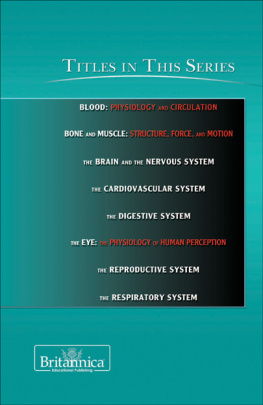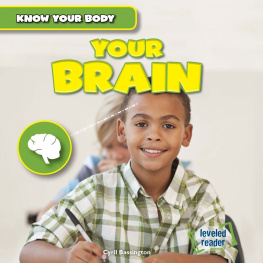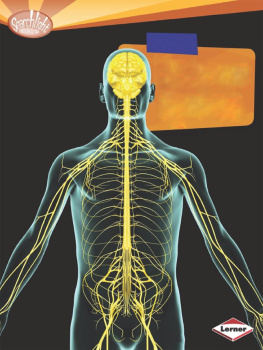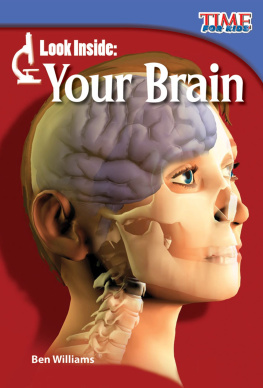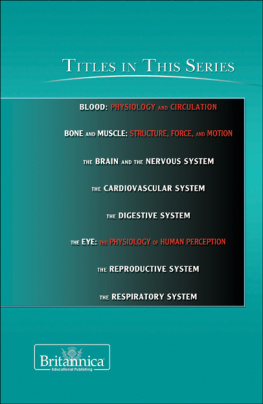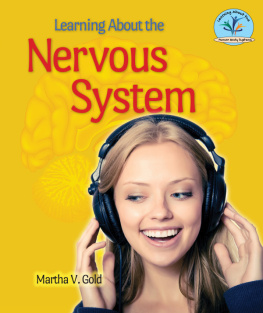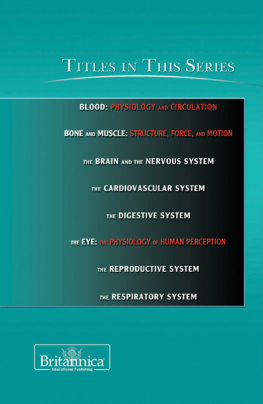THE BRAIN AND THE NERVOUS SYSTEM
THE HUMAN BODY
THE BRAIN AND THE NERVOUS SYSTEM
EDITED BY KARA ROGERS, SENIOR EDITOR, BIOMEDICAL SCIENCES

Published in 2011 by Britannica Educational Publishing
(a trademark of Encyclopdia Britannica, Inc.)
in association with Rosen Educational Services, LLC
29 East 21st Street, New York, NY 10010.
Copyright 2011 Encyclopdia Britannica, Inc. Britannica, Encyclopdia Britannica, and the Thistle logo are registered trademarks of Encyclopdia Britannica, Inc. All rights reserved.
Rosen Educational Services materials copyright 2011 Rosen Educational Services, LLC.
All rights reserved.
Distributed exclusively by Rosen Educational Services.
For a listing of additional Britannica Educational Publishing titles, call toll free (800) 237-9932.
First Edition
Britannica Educational Publishing
Michael I. Levy: Executive Editor
J.E. Luebering: Senior Manager
Marilyn L. Barton: Senior Coordinator, Production Control
Steven Bosco: Director, Editorial Technologies
Lisa S. Braucher: Senior Producer and Data Editor
Yvette Charboneau: Senior Copy Editor
Kathy Nakamura: Manager, Media Acquisition
Kara Rogers: Senior Editor, Biomedical Sciences
Rosen Educational Services
Alexandra Hanson-Harding: Senior Editor
Nelson S: Art Director
Cindy Reiman: Photography Manager
Matthew Cauli: Designer, Cover Design
Introduction by Don Rauf
Library of Congress Cataloging-in-Publication Data
The brain and the nervous system / edited by Kara Rogers.
p. cm. (The human body)
In association with Britannica Educational Publishing, Rosen Educational services.
Includes bibliographical references and index.
ISBN 978-1-61530-256-7 (eBook)
1. Nervous systemPopular works. 2. BrainPopular works. I. Rogers, Kara.
QP355.2.B725 2011
612.8dc22
2010004639
On the cover: The human brain makes up only 2 percent of peoples total body weight. www.istockphoto.com / Sebastian Kaulitzki
Introduction: This image shows a longitudinal section of the human torso showing the autonomic nervous system. 3DClinic/Getty Images
On pages : www.istockphoto.com / Stephen Kirklys
CONTENTS









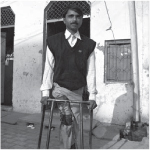
INTRODUCTION

T he smell of fresh baked chocolate-chip cookies. The pain from stubbing a toe. The enjoyment of watching a movie in a theatre. All the sensory details that one absorbs in life travel along the bodys own information superhighway called the nervous system. Composed of central and peripheral components, with the brain as the command centre, the nervous system is responsible for the bodys most fundamental activities. Nerves, which are made up of bundles of fibres, deliver impulses to various parts of the body, including the brain. The brain translates the information delivered by the impulses, which then enables the person to react. The pan is hotput it down fast. The traffic light is redhit the brakes. The brain tells the body how to react based on all the information delivered through the nervous system. Every movement a person makes depends on the nervous system, as do thoughts and communication. In this volume, readers are introduced to the bodys incredible information processing mechanisms and are presented with an opportunity to learn about the intricate system around which the field of neuroscience has developed.
The most basic unit of the nervous system is the nerve cell, also called a neuron. Neurons consist of three parts: a dendrite, a cell body, and an axon, all of which function to transmit information in the form of electrical impulses or signals. Dendrites receive the signals, which then move to the cell body and travel until they reach the end of an axon, or nerve fibre. The signal then crosses a gap (synapse) between the axon and the next dendrite, changing into a chemical signal called a neurotransmitter to bridge the gap. To transmit information through the neurons, the body relies on special cells called receptors. Receptors receive information from both external and internal environments and play an important role in converting this information into electrical impulses. Receptors in the nose, for example, react to molecules in the air and then pass along the smell details through the nerves and along to the brain. Nasal receptor cells are classified as exteroceptive, as are receptors for sight, hearing, touch, and taste. Interoceptive sensors receive signals from inside the body and convey information about internal conditions, such as when the bladder is full or when blood pressure is high. Proprioceptors are stimulated by movements of parts of the body, such as the limbs.
Together, the brain and the spinal cord form what is known as the central nervous system. Though weighing in at a mere 0.9 to 1.4 kilograms (about 2 to 3 pounds), the human brain has an immense capacity to process, retain, and deliver information to the rest of the body. Contained in a protective compartment known as the skull, it consists of billions of neurons. It is comprised of three main sections: the cerebrum, the brainstem, and the cerebellum.
The biggest part of the brain, the cerebrum, has two hemispheres, which consist of two different types of tissue: gray matter and white matter. Because each hemisphere handles distinct functions, the hemispheres are two different sizes. For example, for most people, language ability is in the left hemisphere. The left side also appears to be dominant for math and logic, whereas the right side may be dominant for spatial abilities, face recognition, visual imagery, and music.
The cerebral cortex, made of gray matter, is the thin wrinkled outer layer of the cerebrum. The folding, in effect, creates hills (called gyri) and valleys (called sulci). The number of wrinkles and ridges on the brain may correspond to intelligence on the species level. For example, humans and monkeys, which are capable of complex activities such as reasoning and language, have many ridges compared to mice and rats, which have smooth brains and appear to lack the cognitive abilities known to primates.
Next page
